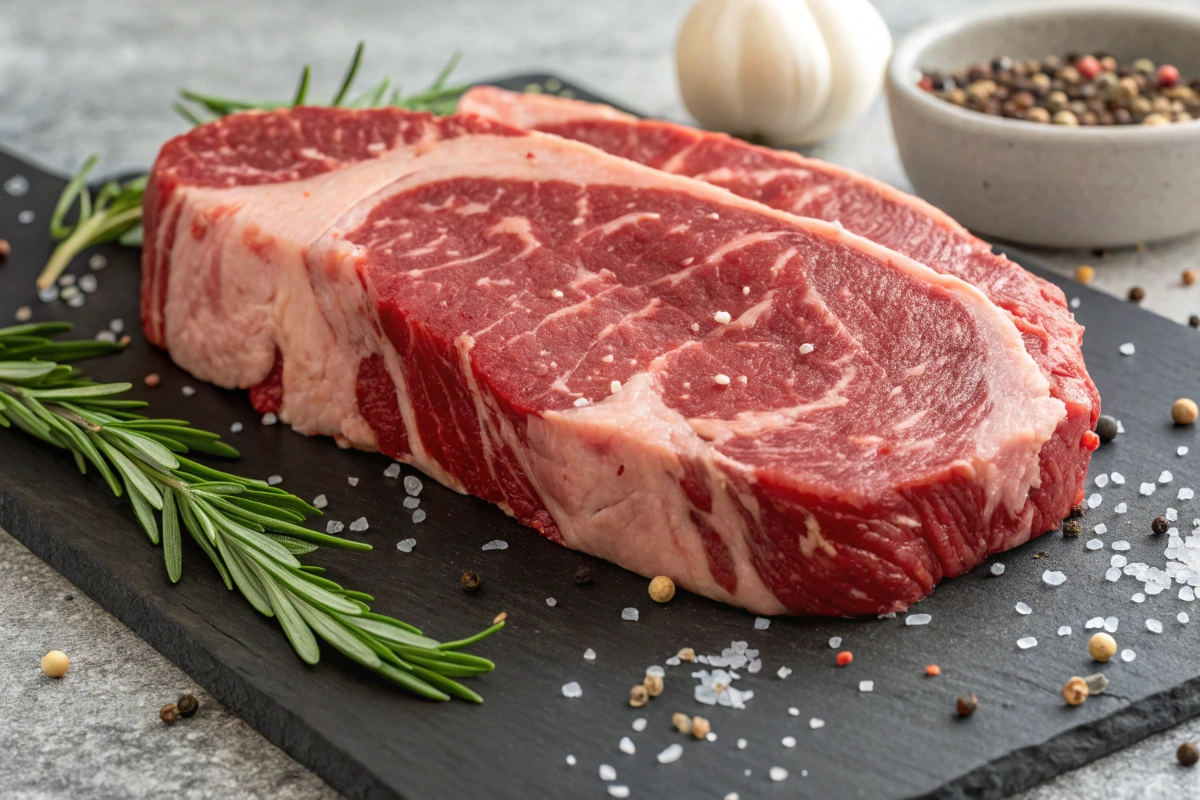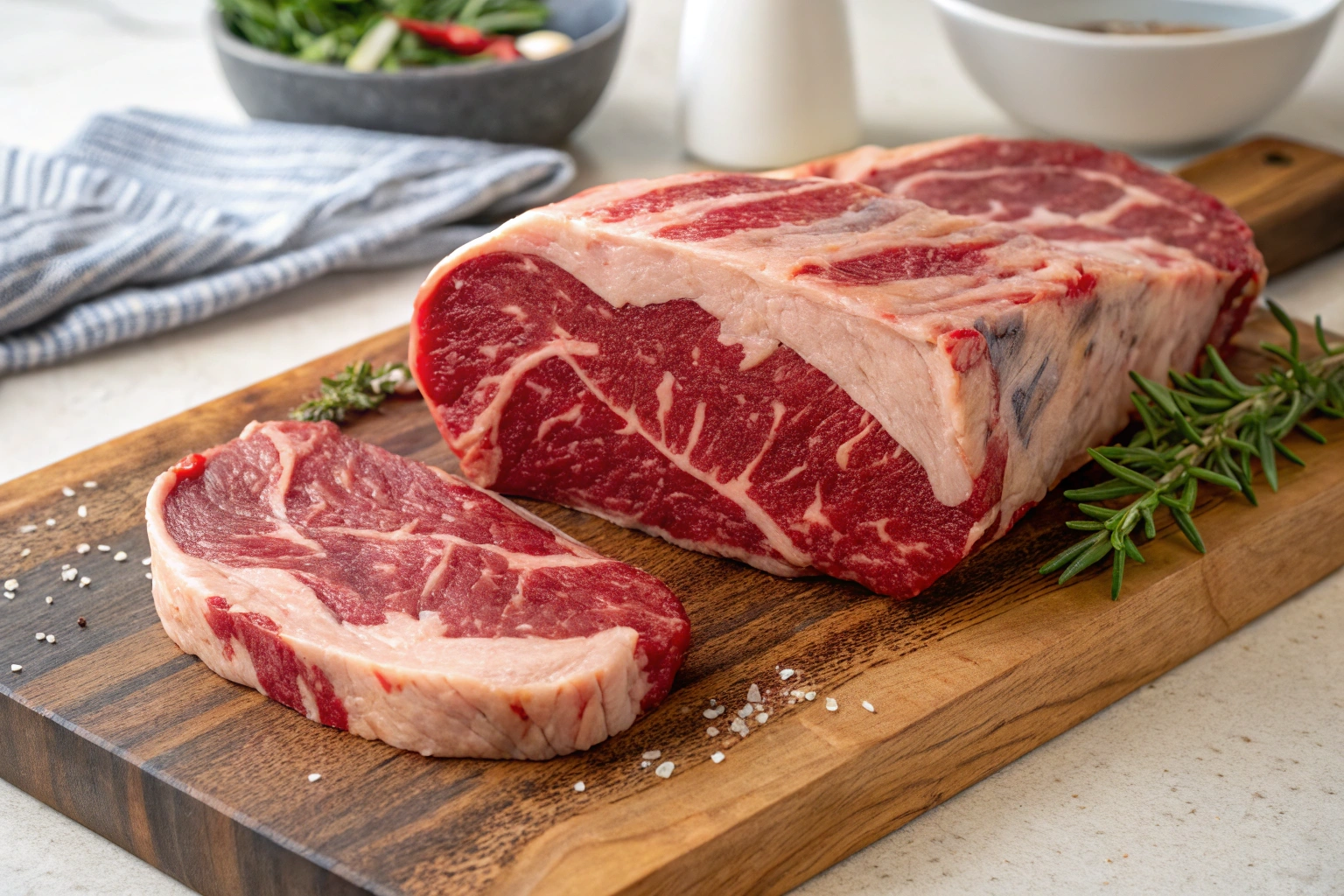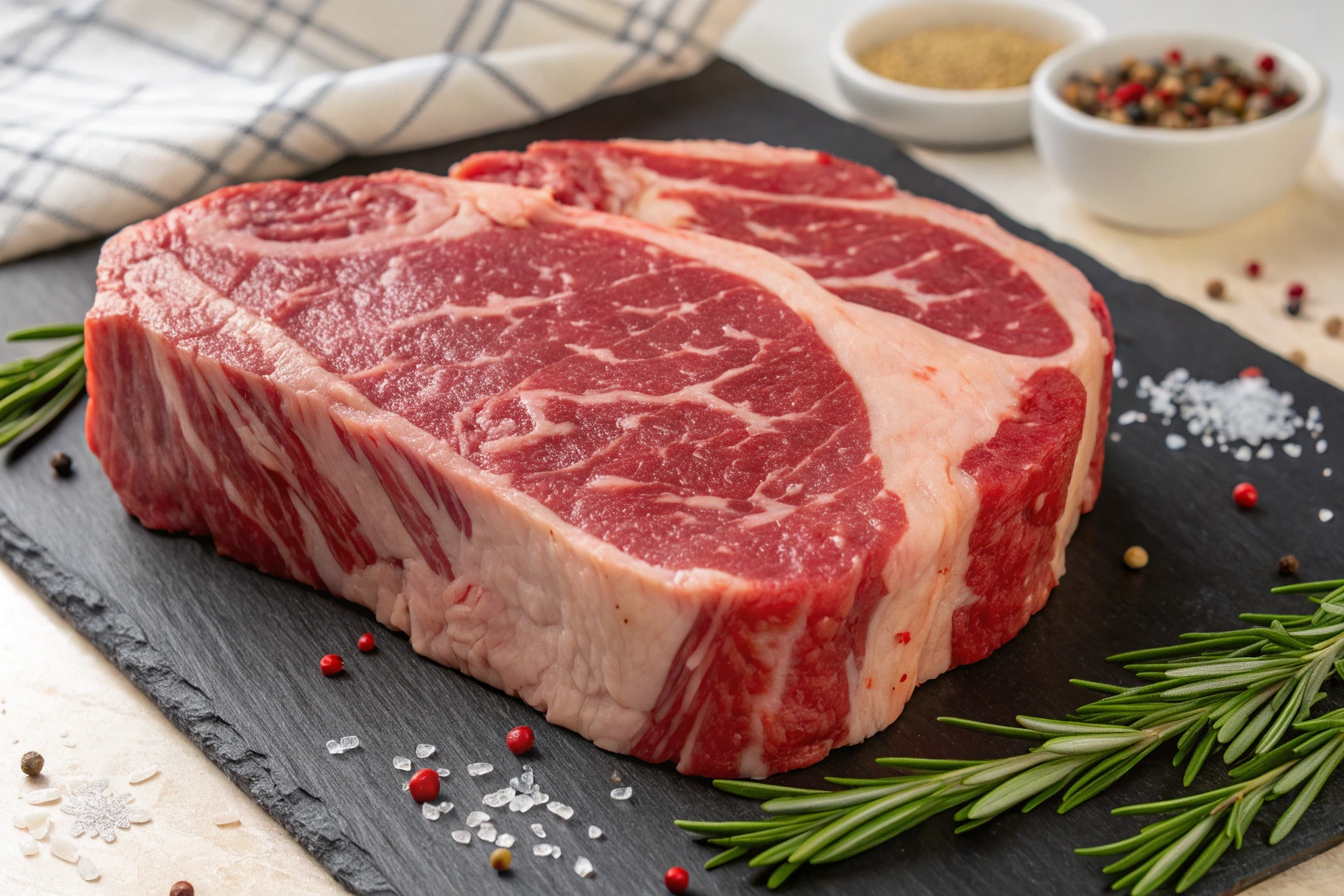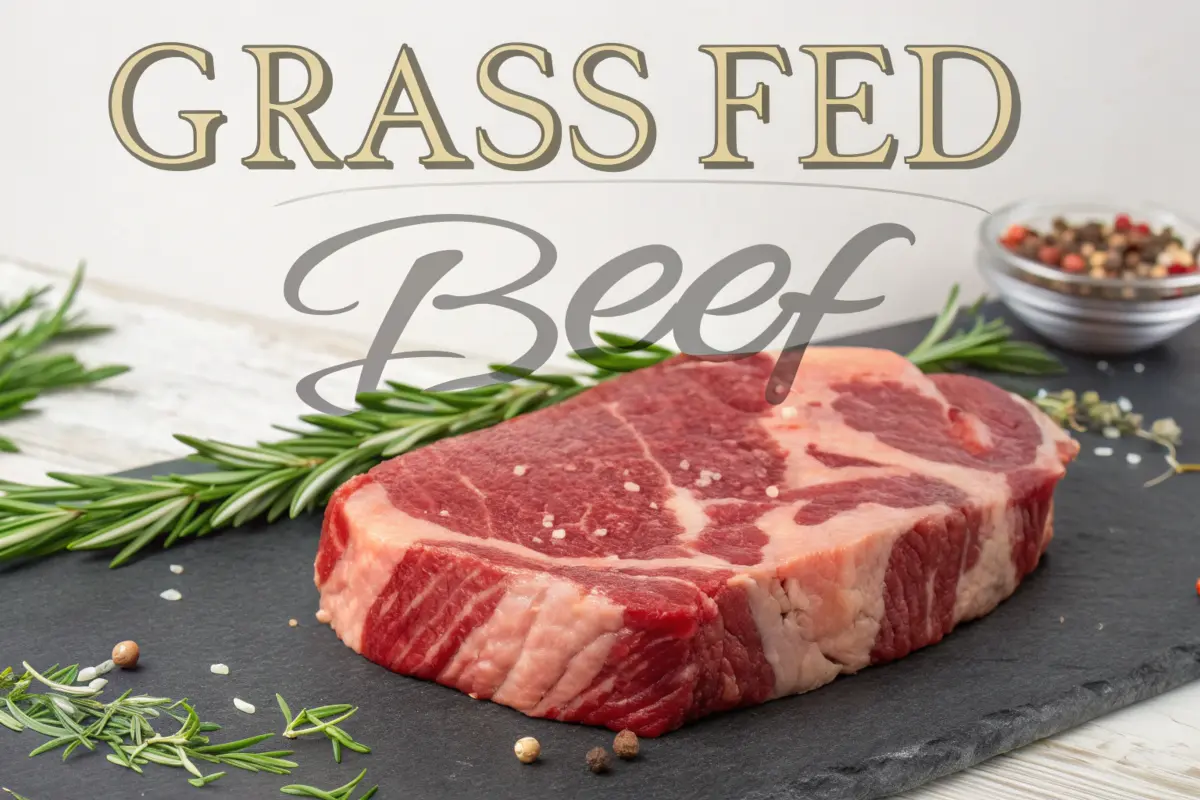What is Grass Fed Beef?
Grass fed beef benefits go beyond just taste and texture; it stems from cattle raised on a natural diet of grass and forage. Unlike grain-fed cattle, which are fed corn and soy to speed up growth, grass-fed cattle graze on pastures, consuming plants that naturally grow in their environment. This natural diet not only enhances the nutritional quality of the beef but also supports the overall well-being of the cattle. As a result, grass-fed beef is considered a more environmentally friendly and ethical option compared to conventionally raised beef.
How Grass Fed Beef Differs from Grain Fed Beef
The most significant difference between grass-fed and grain-fed beef is their diet. Grass-fed cattle graze on pastures, while grain-fed cattle are confined to feedlots and eat grain-heavy diets to accelerate their weight gain.
- Nutritional Composition: Grass-fed beef is leaner and boasts higher levels of healthy fats, including Omega-3 fatty acids, compared to grain-fed beef.
- Taste and Texture: Grass-fed beef has a bolder, more earthy flavor and a firmer texture. In contrast, grain-fed beef tends to be tender with a slightly sweeter taste.
- Environmental Impact: Grass-fed beef is typically considered more sustainable because it uses natural grazing techniques, promoting soil health and minimizing environmental damage.
The Nutritional Benefits of Grass Fed Beef
Grass-fed beef is packed with essential nutrients, offering a healthier alternative to grain-fed beef. Here are some of the key nutritional benefits:
High in Omega-3 Fatty Acids
One of the standout benefits of grass-fed beef is its higher Omega-3 content. Omega-3s are essential for heart health, reducing inflammation, and supporting brain function. Grass-fed beef can contain up to three times more Omega-3 fatty acids than grain-fed beef, making it an excellent choice for anyone looking to boost their intake of these beneficial fats. If you’re looking for other heart-healthy protein options, check out our Chicken and Peppers Recipe.
Rich in Antioxidants and Vitamins
Grass-fed beef is also a rich source of antioxidants such as Vitamin E and Beta-Carotene, which help combat oxidative stress and support immune function. Additionally, grass-fed beef contains higher levels of Vitamin A and B vitamins, which are crucial for energy production and overall health. For more healthy and nutritious recipes, explore our Healthy Cottage Cheese Recipes.
A Healthier Protein Option
With fewer unhealthy fats compared to grain-fed beef, grass-fed beef provides a leaner source of protein. It’s a great option for those mindful of their fat intake and looking to improve their overall protein quality. Grass-fed beef promotes better heart health due to its favorable fat profile. For other leaner protein ideas, consider checking out our Marry Me Chicken Pasta Recipe.

Environmental Impact of Grass Fed Beef
Sustainability and Carbon Footprint
Grass-fed beef production generally results in a lower carbon footprint compared to grain-fed beef. By grazing on pasturelands, cattle naturally fertilize the soil with their manure, helping to maintain healthy soil ecosystems. Unlike large feedlots, which require vast amounts of water and energy to produce feed, grass-fed systems avoid these environmental costs. For more insights on sustainable eating, check out our Healthy Cottage Cheese Recipes.
The Role of Grass Fed Cattle in Land Preservation
Grass-fed cattle farming also helps preserve natural habitats. Instead of cultivating land for grain feed, grass-fed systems utilize natural land management techniques that prevent soil erosion and support local ecosystems. These practices contribute to land regeneration and provide habitats for wildlife, benefiting the local environment in the long term. Learn more about sustainable farming practices through our other blog posts, such as our Grass Fed Beef article.
The Flavor Profile of Grass Fed Beef
How Diet Affects the Taste
The diet of cattle plays a significant role in determining the flavor of their meat. Grass-fed cattle consume a variety of plants, including grasses, herbs, and legumes, all of which contribute unique, earthy flavors. This results in beef that is often leaner and more savory, with a distinct, fuller taste compared to grain-fed meat. If you’re looking for other flavorful meats, try our New York Fried Chicken.
Comparing Grass Fed vs. Grain Fed Flavor
Grass-Fed Beef: The flavor tends to be more robust, with a slightly firmer texture and a rich, earthy undertone. Since grass-fed cattle are leaner, the meat can be less fatty, providing a savory experience.
Grain-Fed Beef: Grain-fed beef is typically milder and sweeter due to the corn and soy in the cattle’s diet. This grain-heavy feed leads to a higher fat marbling, which melts during cooking, creating a juicy, tender steak with a more subtle flavor. If you enjoy steak, consider trying Kennedy Fried Chicken.
Cooking with Grass Fed Beef
Because grass-fed beef is leaner than its grain-fed counterpart, it requires a bit more attention to cooking methods to retain its flavor and tenderness. Understanding these differences can help you achieve the best results when preparing grass-fed beef.
Best Cooking Methods for Grass Fed Beef
To preserve the juiciness and flavor of grass-fed beef, consider these cooking methods:
- Grilling or Pan-Seared: These high-heat methods help lock in moisture while creating a delicious, crispy crust. However, be mindful of cooking times—grass-fed beef cooks faster than grain-fed beef.
- Slow-Cooking or Braising: For tougher cuts like chuck or brisket, slow cooking breaks down the meat’s fibers, resulting in a tender, flavorful dish. This method is ideal for stews or roasts.
- Roasting: Larger cuts of grass-fed beef, such as ribeye or roast, benefit from roasting. This method allows the beef to cook evenly while maintaining its juiciness and tender texture.
Popular Recipes Using Grass Fed Beef
Grass-fed beef can be used in a variety of flavorful dishes. Here are a few popular recipes:
- Grass Fed Beef Burgers: These burgers offer a leaner alternative to regular beef patties. With the right seasonings and toppings, you can achieve a juicy, flavorful burger.
- Grass Fed Beef Chili: A hearty and warming chili made with ground grass-fed beef. The lean meat holds up well in this savory, tomato-based dish, making it a perfect comfort food.
- Steak Frites: A classic French dish, steak frites pairs a perfectly cooked grass-fed steak with crispy fries, balancing rich flavors and textures.

Ethical Considerations in Grass Fed Beef Farming
For many consumers, choosing grass-fed beef aligns with ethical concerns about animal welfare and the treatment of workers in the farming industry. Grass-fed systems often prioritize more humane practices, providing a more transparent and ethical approach to beef production.
Animal Welfare in Grass Fed Systems
Grass-fed beef farming focuses on the well-being of cattle by allowing them to roam freely on pastures. In contrast to industrial feedlots, where cattle are often confined to small spaces, grass-fed cattle have the freedom to graze and engage in natural behaviors. This approach not only promotes better animal health but also leads to less stress for the animals, creating a more humane farming system.
Fair Treatment of Farmers and Workers
Many small-scale, family-run farms are involved in grass-fed beef production, often emphasizing fair labor practices and sustainable farming methods. These operations typically offer better working conditions and fair wages, ensuring that workers are treated with respect and dignity. By supporting these farms, consumers contribute to a more socially responsible food system.
Grass Fed Beef vs. Other Meat Options
While grass-fed beef is often lauded for its health benefits and sustainability, it’s important to compare it to other meat options to determine what might best fit your diet and values.
Grass Fed Beef vs. Free Range Chicken
When comparing grass-fed beef to free-range chicken, both are healthier options than conventionally raised meat. However, there are key differences:
- Nutritional Differences: Grass-fed beef is richer in Omega-3s and other vitamins, while free-range chicken has a slightly higher fat content, which can make it more tender.
- Flavor Profile: Grass-fed beef tends to have a stronger, more earthy flavor, while free-range chicken is generally milder and more versatile in cooking.
- Sustainability: Both options are often seen as more sustainable compared to conventionally farmed meats, with free-range chicken being particularly beneficial for those looking for a lower carbon footprint.
Grass Fed Beef vs. Pasture Raised Pork
Grass-fed beef and pasture-raised pork are both excellent alternatives to factory-farmed meat, though they differ in several aspects:
- Flavor and Texture: Grass-fed beef is leaner and more intense in flavor, while pasture-raised pork is typically more tender and fatty, offering a richer taste.
- Health Benefits: Grass-fed beef contains higher Omega-3s and antioxidants, while pasture-raised pork tends to have a higher concentration of monounsaturated fats, which are also heart-healthy.
- Environmental Considerations: Both options support sustainable farming practices, but pork farming can have a slightly higher environmental impact due to the grain feed required for pigs, though pasture-raised pork is still more eco-friendly than conventional pork.
Cost of Grass Fed Beef
Grass-fed beef is well-known for its superior quality and sustainability, but its price point often exceeds that of conventional beef. Several factors contribute to this higher cost in production and farming practices.
Why Grass Fed Beef is More Expensive
The primary reason for the higher cost of grass-fed beef lies in its farming methods. Grass-fed cattle take longer to raise because they aren’t given grain-based feed to speed up their growth. These cattle require more land to graze, increasing the overall production costs. Furthermore, grass-fed beef farms typically operate on a smaller scale compared to large feedlots, which drives up labor and operational expenses.
Are the Benefits Worth the Cost?
For many consumers, the health and environmental benefits of grass-fed beef justify the price. The meat is leaner, more nutritious, and free from the antibiotics and hormones commonly found in conventionally raised beef. Additionally, supporting sustainable farming practices appeals to those prioritizing ethical food choices. However, due to its higher cost, grass-fed beef may not be affordable for everyone. Balancing these benefits with your budget is essential when making purchasing decisions.
Where to Buy Grass Fed Beef
Finding high-quality grass-fed beef can be an exciting journey. Whether locally or online, various options exist for purchasing this premium meat.
Finding Local Grass Fed Beef Suppliers
Local farmers’ markets and butcher shops often carry grass-fed beef from nearby farms. Buying directly from local suppliers ensures fresh, ethically sourced meat. Local stores frequently offer grass-fed beef at more affordable prices compared to chain supermarkets.
- Farmers’ Markets: A great way to meet the producers and ask about their farming practices.
- Specialty Butcher Shops: Look for butcher shops that specialize in high-quality, sustainable meats.
- Local Farms: Some farms offer direct sales or subscription services for grass-fed beef.
Online Options for Grass Fed Beef
If local suppliers aren’t available, many online stores deliver grass-fed beef straight to your doorstep. Some trusted websites that sell grass-fed beef include:
- ButcherBox: Known for delivering high-quality, grass-fed beef directly to your door.
- Crowd Cow: Sourcing grass-fed beef from small farms across the U.S., this service prioritizes transparency and sustainability.
- Thousand Hills Lifetime Grazed: Focused on providing grass-fed beef from sustainable farming practices.
By purchasing from these reputable online sources, you can enjoy the convenience of home delivery without sacrificing quality.
Popular Grass Fed Beef Brands

When choosing grass-fed beef, it’s essential to consider reputable brands committed to quality and sustainability. Some top brands have earned a strong reputation for producing premium grass-fed beef that meets ethical and environmental standards.
Top Grass Fed Beef Brands to Look Out For
- ButcherBox: Delivers high-quality, 100% grass-fed beef sourced from trusted farms that follow humane practices.
- Thousand Hills Lifetime Grazed: Ensures cattle graze on grass for their entire lives, guaranteeing higher nutritional value and superior taste.
- Primal Pastures: Based in California, Primal Pastures raises 100% grass-fed cattle using regenerative farming practices. Their beef is pasture-raised and free from hormones and antibiotics.
- Crowd Cow: Sources its grass-fed beef from small, sustainable farms around the U.S., offering transparency by allowing consumers to trace their beef back to the farm.
- Verlasso: Known for its high standards in farming practices, Verlasso ensures its cattle are pasture-raised, fed GMO-free diets, and treated humanely.
These brands stand out for their commitment to producing top-quality grass-fed beef.
Grass Fed Beef and Its Role in a Balanced Diet
Including grass-fed beef in your diet supports overall health while offering a flavorful, nutrient-dense protein. It’s an excellent choice for athletes, health-conscious individuals, or anyone who loves good food.
How Grass Fed Beef Fits Into a Healthy Meal Plan
Grass-fed beef is an excellent source of high-quality protein, essential fatty acids, vitamins, and minerals, making it a perfect addition to a balanced meal. It supports muscle growth, immune health, and cardiovascular health due to its favorable fat profile. You can easily add grass-fed beef to meals like salads, stir-fries, or sandwiches.
Pairing Grass Fed Beef with Vegetables and Grains
Pairing grass-fed beef with a variety of vegetables and whole grains creates a nutrient-rich, well-rounded meal. Here are some healthy pairings:
- Vegetables: Roasted root vegetables like carrots, sweet potatoes, or squash complement the richness of grass-fed beef. Leafy greens such as spinach, kale, and arugula provide additional fiber and antioxidants.
- Grains: Brown rice, quinoa, and farro pair well with grass-fed beef, adding fiber, B vitamins, and additional minerals to your meal.
- Legumes: Beans and lentils add plant-based protein, balancing the richness of the beef while providing extra fiber.
This balanced approach ensures you’re getting a wide range of nutrients while keeping your meals satisfying and healthy.
The Future of Grass Fed Beef
As consumer demand for sustainable and healthy food grows, the future of grass-fed beef looks bright. Innovations in farming practices, new technologies, and the potential for increased production are expected to shape the industry.
Trends and Innovations in Grass Fed Beef Production
- Regenerative Agriculture Practices: More grass-fed beef producers are embracing regenerative farming techniques, which go beyond sustainability to restore soil health, improve water retention, and promote biodiversity.
- Technological Advances: From improved grazing management to better pasture rotation systems, innovations in farming technology are helping farmers increase efficiency while reducing environmental impact.
- Traceability: Consumers are increasingly interested in knowing where their food comes from. Brands are adopting technology to provide full transparency and traceability of their beef, from pasture to plate.
These trends help make grass-fed beef production more efficient, sustainable, and widely available.
Predictions for the Grass Fed Beef Market
The market for grass-fed beef is expected to grow as more consumers seek healthier, environmentally friendly meat options. According to industry analysts, grass-fed beef will continue to become more mainstream, driven by increasing demand for clean eating, ethical farming, and sustainable agriculture practices. While the cost may remain higher than conventionally farmed beef, consumers are willing to pay a premium for higher-quality meat that supports their health and values.
Grass Fed Beef benefits and Its Impact on Global Food Systems
Grass-fed beef has the potential to make a significant impact on global food systems, especially as the world faces growing challenges like climate change, food security, and sustainability.
The Potential of Grass Fed Beef for Feeding the World
Grass-fed beef farming, when practiced on a large scale, can contribute to a more sustainable global food system. Grass-fed cattle play a key role in regenerative agricultural models, helping sequester carbon in the soil and reducing the need for chemical fertilizers and pesticides. This sustainable approach can improve soil health, restore ecosystems, and reduce the environmental footprint of farming, making it a viable long-term solution for feeding the world’s population.
By supporting grass-fed beef production, we can also promote better land use and mitigate the effects of desertification and land degradation caused by industrial farming practices.

Frequently Asked Questions (FAQ)
1. What is the difference between grass fed and grass finished beef?
- Grass fed refers to cattle raised on grass for most of their lives, but they may be finished on grain before slaughter. Grass finished means the cattle remain on grass throughout their entire lives, including the final stages before slaughter.
2. Is grass fed beef healthier than regular beef?
- Yes, grass-fed beef is generally healthier than conventionally raised beef. It’s lower in total fat and calories, higher in Omega-3 fatty acids, and contains more beneficial nutrients like antioxidants and vitamins A and E.
3. How can I tell if beef is truly grass fed?
- Look for labels like “100% grass-fed” or “grass-finished,” which indicate that the beef was raised on a grass-only diet. Certifications from organizations like the American Grassfed Association ensure the beef meets strict grass-fed criteria.
4. Is grass fed beef more expensive than regular beef?
- Yes, grass-fed beef typically costs more than conventionally farmed beef. This is due to the slower growth rate of grass-fed cattle, the larger grazing areas needed, and the more sustainable farming practices.
5. Can I cook grass fed beef the same way as regular beef?
- Grass-fed beef requires slightly different cooking techniques due to its leaner nature. It cooks faster and may dry out if overcooked. It’s best to use gentler cooking methods like slow cooking, grilling, or braising.
6. What are the best ways to store grass fed beef?
- Store grass-fed beef the same way as regular beef—keep it refrigerated and consume it within a few days, or freeze it for longer storage. Vacuum-sealing can help preserve its freshness.
Conclusion
In conclusion, grass-fed beef offers a wide range of benefits, from superior nutrition to environmental sustainability and ethical farming practices. By choosing grass-fed beef, you improve your health and support a more sustainable and humane food system. Whether you want a healthier protein source, a better flavor, or a more eco-friendly option, grass-fed beef is an excellent choice for your diet. With growing accessibility and increasing consumer demand, the future of grass-fed beef is brighter than ever.
Make the switch today! Look for trusted sources of grass-fed beef, educate others on its benefits, and support sustainable farming. Every purchase you make contributes to a healthier planet and a better food system for future generations.


3 thoughts on “Grass-Fed Beef: Discover Its Nutrition, Rich Flavor, and Environmental Impact”